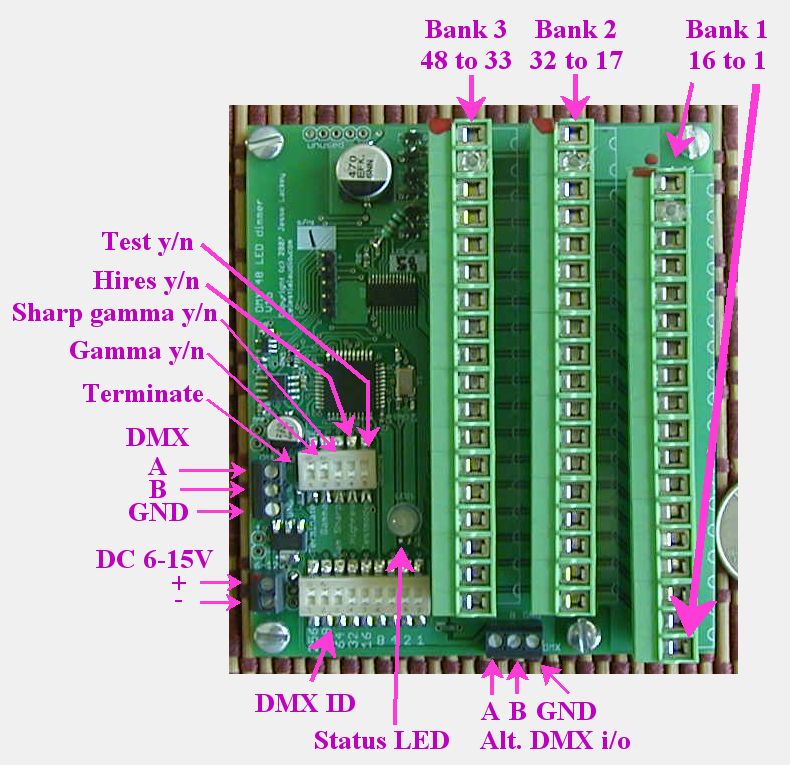48 channel DMX dimmer pack for LEDs
PLEASE NOTE: this design has been replaced with a version 2, details here.
(This webpage is kept online for the convenience of existing customers.)
This
board is for sale!
Board size: 3.5" x 4.0", with 4 holes for 6-32 screws; a set of 4
1/4"
standoffs are provided. There are 3 holes at the
corners and one near the bottom right, at 2.49" x 0.16"
relative to lower left corner.
Top view:

Feature set (for version 1; go here for Version 2):
- 48 channels with one small board! No more
compromises due
to not having as many channels as you really want.
- Each channel provides 20mA
of current-controlled switching.
No external current limiting resistors needed. Hook up your
LED(s) and go.
- Each channel can switch up to 15V,
so several LEDs can be wired in series per channel.
- Refresh rate is approximately 400Hz.
- 3 selectable intensity scaling curves for linear perceived
brightness with linearly increasing DMX values ("gamma
correction").
This is possible because the board actually runs at 4096 levels (12
bits) per LED. These scaling curves allow 8-bit DMX to have a
wide dynamic range, with excellent "resolution" at the dimmest settings.
- LED brightness levels retained if DMX signal is lost.
- DMX ID settable 1-511 via DIP switch, changes are immediate (no
power off and back on needed), status LED blinks orange to acknowledge
setting change.
- DMX termination on/off via DIP switch. No jumpers or plugs
to deal with.
- Run test chase pattern yes/no via DIP switch, which is very handy
for
debugging installations.
- High-resolution (16-bit DMX) mode yes/no via DIP switch.
This allows the ultimate in precise dimming control with 4096 levels!
- Multicolor status LED indicates DMX protocol or wiring error
(red), no DMX wire connection or no data on connection
(green slow blink), and valid DMX frames incoming (green fast blink).
- Supports the top speed possible with DMX: 512 channel frames @
44fps.
- LED connection headers are a unique "pluggable" design: they can
be unplugged
from the board, wires added/removed, then plugged back in. They
can be plugged in two ways: such that the wires exit up out of the
board (shown in in picture) or more conventionally parallel to the
board. This allows for much easier installation and for moving
installations, since the board and the LED clusters are easily
separated.
- Board electronics runs from 6-15V DC @ 100mA typical/250mA peak,
reverse polarity
protected. 5V powering
possible with caveats; ask for details if this would be beneficial to
your application. (Note that this doesn't include the power
consumed by your LEDs, which is approximately 900mA maximum.) A
regulated power supply is needed; cheap
"wall-wart" supplies typically output several volts higher than their specification, so
a garden-variety "12V" wall-wart may put out 15V or more. This
may damage the board. Feel free to ask me about suitable power
supplies or how to tell if yours will work safely.
- The DMX and DC power input have plated input holes on the board
(in addition to the terminal blocks) to allow wires to be directly
soldered to
the board if desired.
- Up to 16 boards can run from a single DMX source, so a complete
DMX
universe of 512 channels can be easily built.
Since this board is intended to be installed in an enclosure with other
equipment, and wiring requirements are highly dependent on the
installation, there is
no case provided and the DMX connection is with a terminal block
instead
of a bulky 3 or 5-pin (standard? what standard???) XLR. See
wiring diagram below for details.
The basic operation is that this board switches the negative of your LED clusters to
the LED power supply's ground. This is called low-side switching,
and is the most common way things like this are done, since it is
simpler, cheaper, and a little more efficient than switching the
positive of the LED clusters (called high-side switching).
The wiring diagram is here.
Some notes about the wiring:
- Each of the three LED terminal blocks (each "bank") have a common
positive to
be wired to each of the 16 LEDs (or LED clusters) in that bank.
- LED (or LED cluster) negative goes to terminal block.
- This system does 3-way multiplexing, in that each terminal block
of 16 is actually powered on at 55mA 1/3 of the time. This is
very typical of LED displays, and LEDs are designed to operate this
way. For more details, or to request an alternate current level
(a simple change) please contact me.
PLEASE NOTE: this design has been replaced with a version 2, details here.
DMX LED Home
Celestial Audio Home
